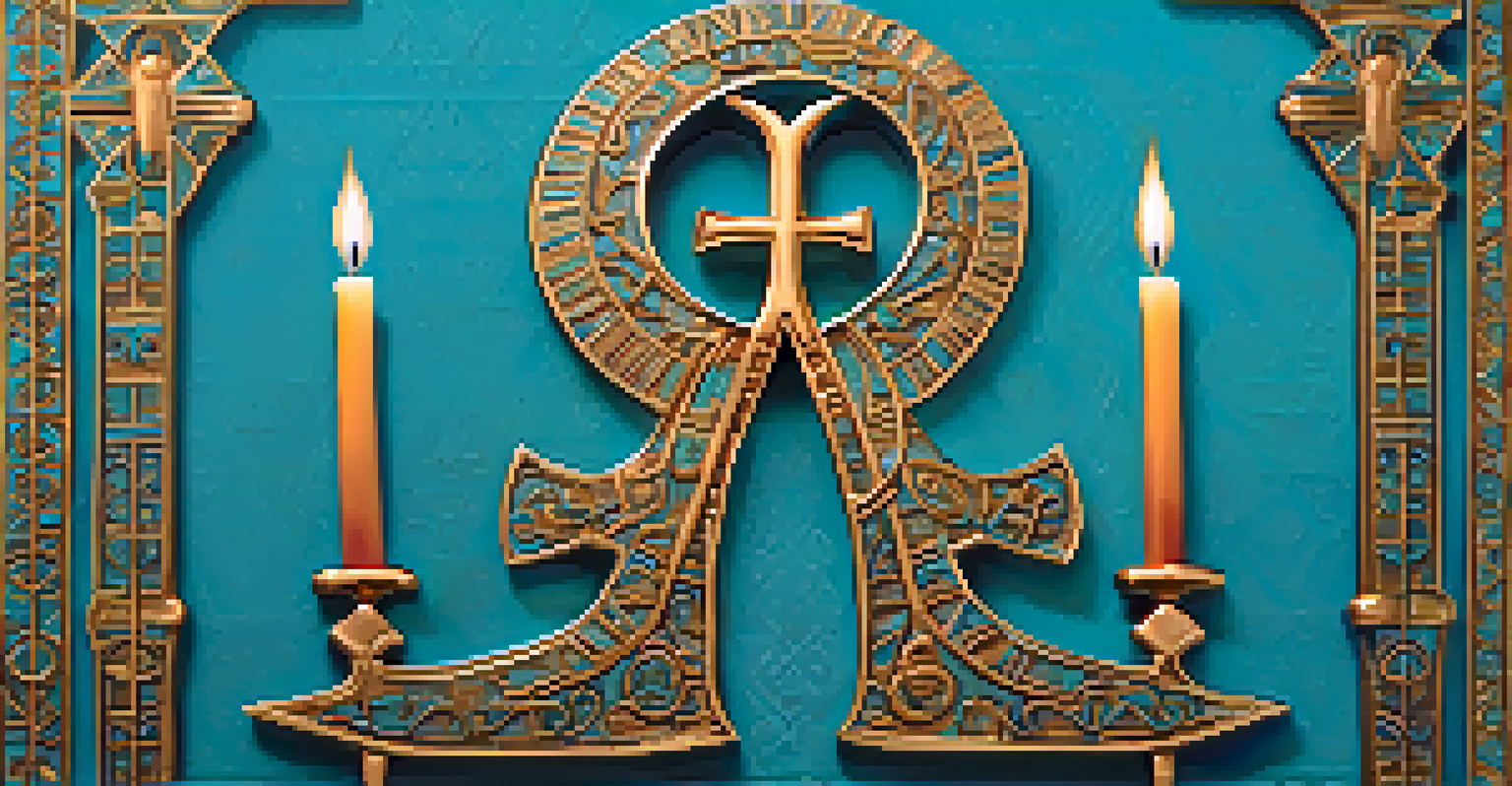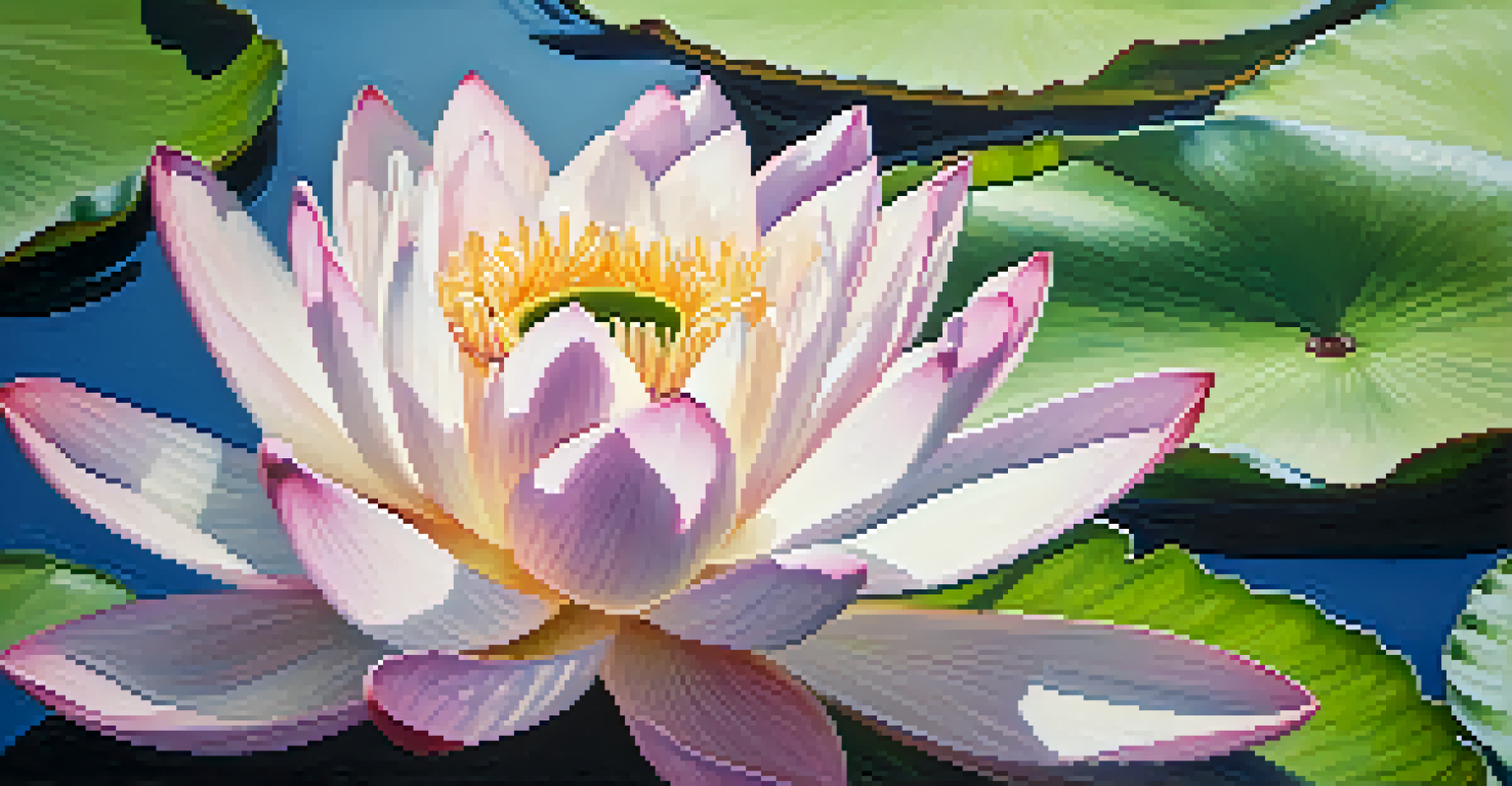Exploring Spiritual Symbols and Their Meaning in Life

What Are Spiritual Symbols and Why Do They Matter?
Spiritual symbols are visual representations that convey deeper meanings and concepts related to spirituality and human experience. Think of them as a universal language that transcends words, allowing us to connect with something greater than ourselves. Examples include the lotus flower, which symbolizes purity and enlightenment, or the yin-yang, representing balance in life. Understanding these symbols can enrich our spiritual journey and offer guidance in our everyday lives.
Symbols are the language of the spirit, speaking to our souls in ways that words often cannot.
These symbols often originate from various cultures and religious traditions, each carrying unique interpretations. For instance, the cross in Christianity signifies sacrifice and love, while the Om symbol in Hinduism represents the essence of the universe. By exploring these symbols, we not only gain insight into different beliefs but also discover how they can resonate with our personal experiences. This exploration fosters a greater appreciation for diversity in spirituality.
Moreover, spiritual symbols can serve as reminders of our values and aspirations. When we encounter these symbols in our daily lives, they can inspire us to reflect on our purpose and direction. This connection can be as simple as wearing a symbol as jewelry or having it displayed in our homes. In essence, spiritual symbols are tools that can guide us toward a more meaningful and intentional life.
Common Spiritual Symbols and Their Meanings
Many spiritual symbols are widely recognized and carry profound meanings. The dove, for example, often symbolizes peace and hope, making it a popular emblem in various spiritual contexts. Similarly, the tree of life represents interconnectedness and growth, reminding us that we are all part of a larger ecosystem. Familiarizing ourselves with these symbols can deepen our understanding of the messages they convey.

Another powerful symbol is the ankh, an ancient Egyptian representation of eternal life. It serves as a reminder of the cycle of life and death, encouraging us to embrace our mortality while celebrating our existence. The spiral, often seen in nature, symbolizes evolution and the journey of the soul, illustrating that our spiritual paths are not linear but rather a continuous unfolding of experiences.
Spiritual Symbols Enhance Understanding
Exploring spiritual symbols deepens our appreciation for diverse beliefs and enriches our personal experiences.
Recognizing and reflecting on these symbols can offer comfort and insight during challenging times. For instance, when feeling lost, the compass symbol may remind us to trust our intuition and navigate our personal journeys. By incorporating these symbols into our daily lives, we cultivate a sense of connection to something larger than ourselves, fostering peace and understanding.
The Role of Colors in Spiritual Symbols
Colors play a crucial role in enhancing the meanings of spiritual symbols. Each color carries its own set of emotions and associations, which can deepen our connection to the symbols they adorn. For instance, blue often symbolizes tranquility and spiritual insight, while red may represent passion and energy. Understanding the significance of colors can enrich our interpretation of spiritual symbols.
Every symbol is a doorway to a deeper understanding of our shared humanity and the universe.
Take the rainbow, for example. Each color in the spectrum can represent different aspects of life and spirituality, from red's grounding energy to violet's connection to the divine. When we see a rainbow, it serves as a reminder of hope and the beauty that follows storms in our lives. This interplay between color and symbol can create a more profound experience, inviting us to reflect on our own journeys.
Incorporating colors into our spiritual practices, such as meditation or visualization, can enhance our connection to the symbols we resonate with. For instance, meditating on a green symbol can evoke feelings of healing and growth. By being mindful of both symbols and colors, we can create a more holistic approach to our spiritual lives.
Personalizing Spiritual Symbols for Your Journey
Personalizing spiritual symbols can make them even more meaningful in our lives. Each person's journey is unique, and the symbols that resonate with us may differ from those of others. Reflecting on your experiences, values, and aspirations can help you identify symbols that speak to your soul. This personalization allows spiritual symbols to become powerful anchors in our lives.
For example, if you find strength in nature, you might resonate with a specific tree or animal symbol that represents your connection to the earth. By incorporating this symbol into your daily routine, perhaps through art or meditation, you create a constant reminder of your values and goals. Personalization can transform a generic symbol into a deeply personal talisman that guides and inspires you.
Colors Add Meaning to Symbols
The significance of colors in spiritual symbols enhances their meanings and our emotional connections to them.
Additionally, creating your own symbols can be a liberating process. You might choose to combine elements from various symbols that represent different facets of your life. This creative expression not only deepens your understanding of spirituality but also empowers you to define your own path. Remember, your spiritual journey is yours alone, and personalizing symbols can enrich that experience.
How Spiritual Symbols Influence Our Daily Lives
Spiritual symbols can significantly influence our daily lives, often serving as reminders of our values and intentions. For instance, wearing a symbol around our neck or having it on our desk can evoke feelings of peace, strength, or inspiration throughout the day. This small gesture can create a positive shift in our mindset, encouraging us to act in alignment with our spiritual beliefs.
Moreover, spiritual symbols can help us navigate life's challenges. When faced with difficult decisions, we might find solace in a symbol that represents clarity or guidance, reminding us to trust our inner wisdom. These symbols can act as touchstones, grounding us during turbulent times and keeping us connected to our spiritual selves.
Additionally, sharing symbols with loved ones can foster deeper connections and conversations about spirituality. When we discuss the meanings and significance of certain symbols, we create opportunities for growth and understanding within our relationships. In this way, spiritual symbols not only enrich our personal journeys but also enhance our interactions with others.
The Intersection of Spiritual Symbols and Mental Health
The relationship between spiritual symbols and mental health is a fascinating area of exploration. Many people find comfort and solace in spiritual symbols during difficult times, helping to alleviate feelings of anxiety or depression. For instance, a simple symbol like a heart can remind us to focus on love and compassion, both for ourselves and others, fostering a more positive mindset.
Incorporating spiritual symbols into mindfulness practices can also be beneficial. When we meditate on a symbol, we shift our focus away from negative thoughts and center ourselves in the present moment. This practice can promote relaxation and emotional well-being, leading to a more balanced state of mind. By engaging with spiritual symbols, we create a sense of purpose and connection that can enhance our overall mental health.
Personalization Deepens Spirituality
Personalizing symbols allows individuals to create powerful reminders that resonate with their unique spiritual journeys.
Moreover, sharing the meanings of spiritual symbols with others can spark conversations that promote healing and understanding. When we discuss how certain symbols impact our mental health, we create a supportive community that encourages open dialogue. This exchange can help break down barriers and foster a sense of belonging, reinforcing the idea that we are not alone in our struggles.
Embracing Spiritual Symbols in Everyday Rituals
Incorporating spiritual symbols into our daily rituals can deepen our connection to spirituality and enhance our overall well-being. Simple practices like lighting a candle with a specific symbol can create a sacred space for reflection and meditation. This act transforms a mundane moment into a profound experience, allowing us to connect with our intentions and aspirations.
Another way to embrace spiritual symbols is through journaling. By writing about the symbols that resonate with us, we can explore their meanings and how they relate to our lives. This reflective practice encourages self-discovery and personal growth, helping us align our actions with our spiritual beliefs. Over time, our journals can serve as a rich tapestry of our spiritual journey.

Additionally, creating rituals around significant symbols can foster mindfulness and gratitude in our lives. For example, setting aside time each week to focus on a specific symbol can help us cultivate awareness of its significance. As we engage with these symbols regularly, we develop a deeper understanding of their meanings and how they relate to our lives, ultimately leading to a more fulfilling spiritual experience.